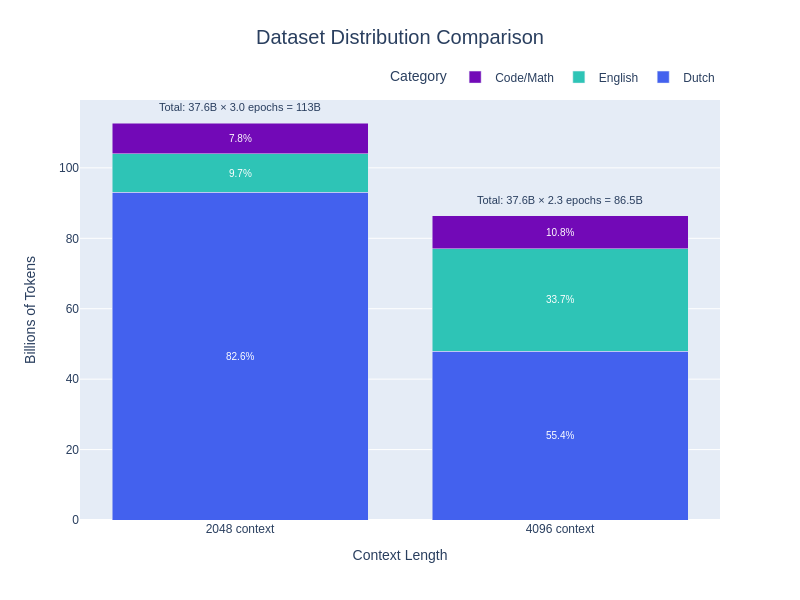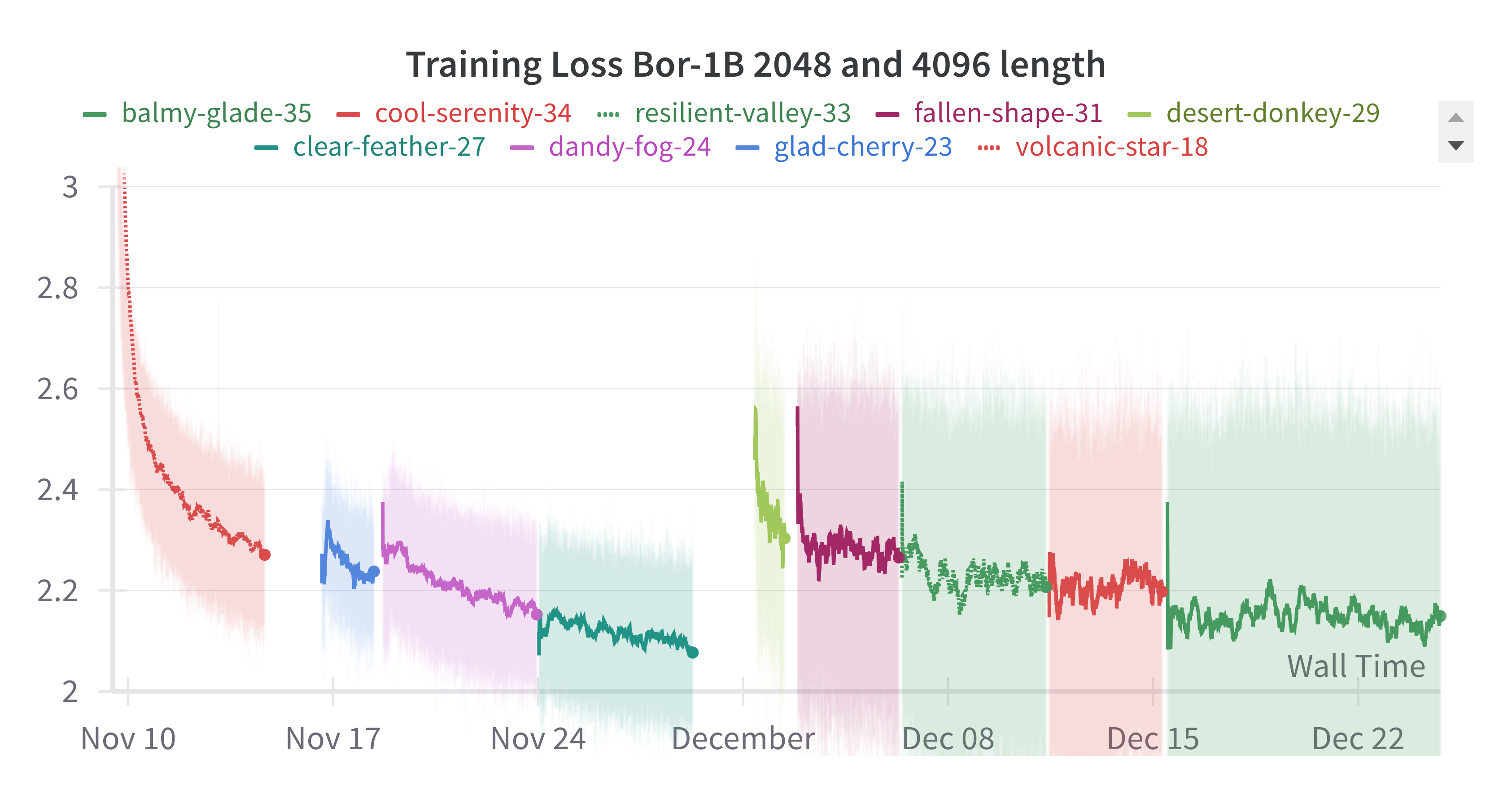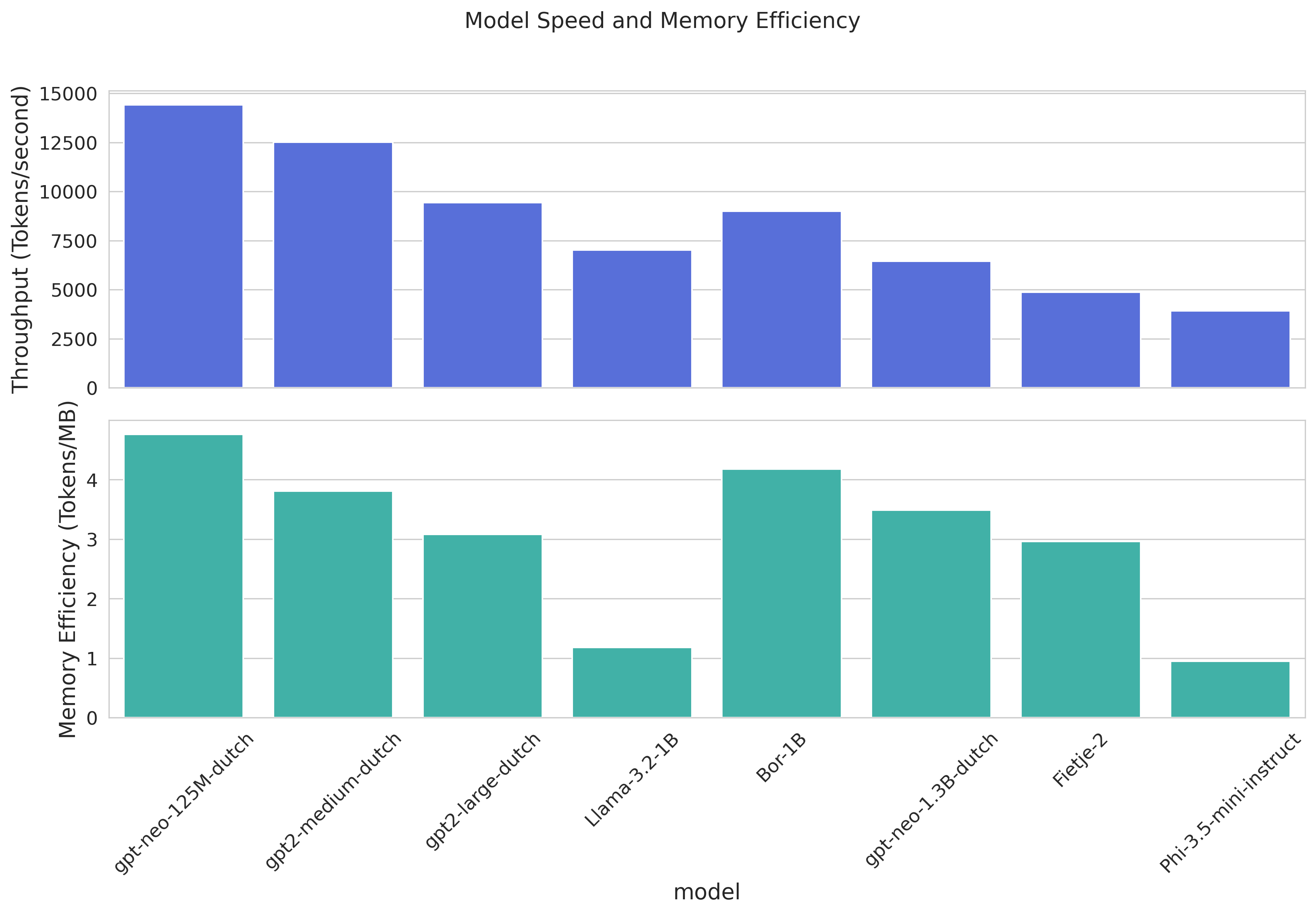Bor-1B - Dutch/English Pre-trained Language Model
Model Description

Bor-1B is a pre-trained multilingual language model based on the Mistral architecture, specifically designed for Dutch and English language processing. The model was pre-trained in two phases with different context lengths and dataset compositions.
The model's name pays homage to "Bor de Wolf" from the beloved Dutch children's series De Fabeltjeskrant (1968-1989). While the original Bor was famous for his signature "Huuuuu!" howl echoing through the forest, this Bor's howls are more subtle - processing Dutch and English text without disturbing the neighbors!
Architecture
The Mistral architecture was chosen for its broad library support and efficient implementation. The Bor-1B model maintains Mistral's core structural elements while scaling down dimensions for a more compact design:
Model Scale: ~1.19B parameters vs Mistral's 7B, primarily due to reduced width:
- Hidden size: 1536 vs 4096
- Intermediate MLP size: 6144 vs 14336
- Attention heads remain at 32 with 8 KV heads (4:1 grouping ratio)
- Layer depth maintained at 32 layers
Key Similarities:
- Sliding window attention (4096 tokens)
- Vocabulary size (32K tokens)
- Number of attention heads and KV heads
- Model depth (32 layers)
- Basic architecture components (RMSNorm, SiLU activation)
RoPE:
- A higher RoPE base frequency (θ = 80000 vs Mistral v0.1's 10000) was chosen to potentially improve extrapolation to sequences longer than those seen during training.
Tokenizer
The model uses the dutch-llama-tokenizer, a 32K BPE tokenizer specifically optimized for Dutch-English bilingual content and code. This tokenizer was selected for its optimal balance between:
- Efficient tokenization of Dutch text (comparable to specialized Dutch tokenizers)
- Strong performance on English and code
- Compact vocabulary size (32K tokens) suitable for smaller models
- Comprehensive character coverage including special characters for code and math
Benchmarks show it achieves tokenization efficiency within 5-10% of specialized single-language tokenizers while maintaining a vocabulary size appropriate for 1-2B parameter models. For mixed Dutch-English-code content, it typically requires 10-15% fewer tokens than general-purpose tokenizers like Mistral's.
Training Data
The model was trained in two phases with different context lengths and dataset compositions:
Phase 1 (2048 context length)
Total tokens: 37.6B tokens × 3 epochs = 113B total
- Primary Dutch content (~82%): MC4 Dutch Cleaned, Wikipedia, GeminiPhiDutch and additional Dutch datasets
- English content (~12%) from curated sources, including goodwiki
- Python code (~6%) for programming capabilities: Python subsets from CodeSearchNet and github-code-clean
Phase 2 (4096 context length)
Total tokens: 37.6B tokens × 2.3 epochs = 87B total
- Balanced composition: Dutch (55%), English (34%), and specialized content (~11%)
- Dutch content: MC4 Dutch Cleaned, Wikipedia, GeminiPhiDutch, CulturaX Dutch(*)
- English content: Zyda-2, goodwiki and additional curated sources
- Code and mathematics (~10%): Python from CodeSearchNet and github-code-clean, plus FineWeb-math and FineWeb-code
- Instruction tuning (~2%): OpenHermes 2.5 (85%) and OpenHermes 2.5 Dutch (15%)
The second phase features a more balanced language distribution and enhanced code/mathematics representation to improve the model's capabilities across natural language and technical tasks.
Training Details
Hardware and Infrastructure
- Training hardware: TPU v4-32
- Training duration: 45 days (Nov 10 - Dec 24, 2023)
Training Configuration
Common settings:
- Optimizer: AdamW (β1=0.92, β2=0.999, ε=1e-7)
- Weight decay: 0.1
- Z-loss: 0.0001
- Precision: bfloat16
- Attention implementation: sharded vanilla attention
Phase 1 (2048 context):
- Batch size: 128 (gradient accumulation: 2)
- Learning rate: 3e-4 → 5e-5 (linear decay)
- Warmup steps: 4000
- Training epochs: 2 (37B tokens × 3 epochs = 112B tokens)
- Max gradient norm: 0.7
Phase 2 (4096 context):
- Batch size: 32 (gradient accumulation: 8)
- Learning rate: 1.5e-4 → 3e-5 (linear decay)
- Warmup steps: 10000
- Training epochs: 1 (37B tokens × 2.4 epochs = 87B tokens)
- Max gradient norm: 1.0
Training Dynamics
Training required multiple restarts due to software and infrastructure constraints, resulting in repeated learning rate warmups visible in the loss curves. Despite these interruptions, the model demonstrated stable convergence:
- Final training loss stabilized around 2.1-2.2 after initial optimization
- Phase 2 (4096 context) shows higher loss, most likely due to dataset composition:
- More diverse content mix (34% English vs 12% in Phase 1, inclusion of CulturaX for Dutch)
- More of technical content (mathematics, code)
- Multiple warmup cycles visible but maintained consistent loss levels
Evaluation
Perplexity Evaluation
The model's perplexity was evaluated on MC4 NL Cleaned, CulturaX NL and Fineweb Edu sets, measuring both token-level and word-level perplexity. Word-level perplexity accounts for subword tokenization by averaging log probabilities across tokens within whitespace-delimited words. The violin plots show Bor-1B achieves competitive perplexity distributions compared to similarly-sized models, with median token perplexities around 15 on both datasets.
The violin plots above show perplexity distributions across different models and datasets. Several interesting patterns emerge:
- Bor-1B achieves lower median perplexities than the older gpt2 dutch models.
- The distribution is notably tighter than the GPT-2 family models, indicating more consistent performance across different text samples
- The Dutch-only GPT-2 models show relatively small gaps between their token and word-level perplexities
- In contrast, multilingual models (Llama-3.2-1B, Phi-3.5-mini-instruct) and Bor-1B show larger differences between token and word perplexities
- This pattern likely reflects different tokenization strategies: multilingual models may use more subword tokens per Dutch word, leading to different word-level perplexity characteristics
- Bor-1B demonstrates comparable word-level perplexities compared to Llama-3.2-1B
- This suggests that Llama's lower token-level perplexity may be due to using more subword tokens per Dutch word, where predicting continuation tokens is typically easier than predicting initial word tokens
- Fietje-2 (2.7B) shows the lowest token and word-level complexity of all tested models on Dutch.
- Phi3.5-mini-instruct (3.5B) shows the lowest token and word-level complexity on Fineweb Edu.
Speed and Memory Efficiency
Bor-1B's performance was evaluated across two metrics:
Throughput and Memory Efficiency
- Forward-Pass Speed: Forward pass duration measured in tokens/second during batch processing for parallel inference tasks
- Peak Memory Utilization: Measured in tokens/MB during batch inference
The metrics demonstrate Bor-1B's efficient balance of speed and memory usage with its 1B parameters and 4K context window. Actual performance varies by hardware configuration and inference parameters.
Full evaluation methodology: evaluation script
Intended Use
- Rapid experimentation with Mistral architecture for Dutch/English tasks
- Single-task fine-tuning (e.g., text simplification, translation) where context contains all necessary information
- Research and development of Dutch language capabilities
- Lightweight applications requiring basic Dutch/English understanding
Data Considerations and Limitations
- Tiny model size by current standards (~1.19B parameters and 0.2T tokens trained on) limits complex reasoning and generation capabilities
- Not suitable for high-quality chat responses from simple prompts
- Best performance achieved when full context/information is provided in the prompt
- Performance may vary between Dutch and English
- Domain-specific performance depends on training data distribution
- Architectural choice of maintaining 32 layers results in suboptimal inference speed for the parameter count
- As parts of the training data (CulturaX, MC4) are derived from CommonCrawl, the model may have been exposed to personal or sensitive information despite cleaning efforts
License
Model License
This model and its weights are licensed under the Apache License 2.0.
Dataset Licenses
The training data includes content from multiple sources with different licenses:
- CulturaX: Inherits licenses from:
- MC4-NL-cleaned: ODC-BY license, subject to Common Crawl terms of use
- Additional datasets: See respective repository licenses
Citations
If you use this model, please cite both the model and relevant datasets:
@article{2019t5,
author = {Colin Raffel and Noam Shazeer and Adam Roberts and Katherine Lee and
Sharan Narang and Michael Matena and Yanqi Zhou and Wei Li and
Peter J. Liu},
title = {Exploring the Limits of Transfer Learning with a Unified
Text-to-Text Transformer},
journal = {arXiv e-prints},
year = {2019},
archivePrefix = {arXiv},
eprint = {1910.10683}
}
@article{husain2019codesearchnet,
title = {{CodeSearchNet} Challenge: Evaluating the State of Semantic Code Search},
author = {Husain, Hamel and Wu, Ho-Hsiang and Gazit, Tiferet and
Allamanis, Miltiadis and Brockschmidt, Marc},
journal = {arXiv preprint arXiv:1909.09436},
year = {2019}
}
@misc{Zare_Chavoshi_2023,
title = {EasyDeL, an Open-Source Library for Enhanced Training of JAX/Flax Models},
url = {https://github.com/erfanzar/EasyDeL},
journal = {EasyDeL Easy and Fast DeepLearning with JAX},
publisher = {Erfan Zare Chavoshi},
author = {Zare Chavoshi, Erfan},
year = {2023}
}
@misc{GoodWiki,
title = {GoodWiki Dataset},
author = {Choi, Euirim},
howpublished = {\url{https://www.github.com/euirim/goodwiki}},
month = {September},
year = {2023}
}
@inproceedings{nguyen-etal-2024-culturax,
title = "{C}ultura{X}: A Cleaned, Enormous, and Multilingual Dataset for Large
Language Models in 167 Languages",
author = "Nguyen, Thuat and others",
booktitle = "Proceedings of the 2024 Joint International Conference on Computational
Linguistics, Language Resources and Evaluation (LREC-COLING 2024)",
year = "2024",
pages = "4226--4237"
}
@inproceedings{Huang2024OpenCoderTO,
title = {OpenCoder: The Open Cookbook for Top-Tier Code Large Language Models},
author = {Huang, Siming and Cheng, Tianhao and Liu, Jason Klein and
Hao, Jiaran and Song, Liuyihan and Xu, Yang and Yang, J. and
Liu, J. H. and Zhang, Chenchen and Chai, Linzheng and
Yuan, Ruifeng and Zhang, Zhaoxiang and Fu, Jie and Liu, Qian and
Zhang, Ge and Wang, Zili and Qi, Yuan and Xu, Yinghui and
Chu, Wei},
year = {2024},
url = {https://arxiv.org/pdf/2411.04905}
}
Acknowledgements
This project would not have been possible without compute generously provided by Google through the TPU Research Cloud. Training was implemented using EasyDeL, an Apache v2 licensed open-source framework for efficient training of language models on TPU/GPU with JAX/Flax.
Created by Yeb Havinga
- Downloads last month
- 158



